#bunkin takashimada
Explore tagged Tumblr posts
Note
Hey, sorry to bother you but can you make more head cannons with Arata U please. 🥺
Can you right about a wedding or engagement?
Watashi no Shiawase na Kekkon ~Marriage~
Manga/anime: Watashi no Shiawase na Kekkon
Warnings: nothing
U. Arata
Know you're truly a special person if he has decided to dedicate his entire life to you forever
It'll probably be several years of engagement before he proposes to you and, speaking of that, his proposal will be done in an absolutely traditional way: after having had the approval of his grandfather, he'll go to your parents to personally ask them for your hand; after their blessing, he'll take you on a date, which will end in the garden of his -and soon also yours- villa, where he'll kneel down, gently taking your hand and asking you to be his wife
Your wedding will also be totally traditional: he'll wear the typical male wedding attire while you'll wear a Shiromuku with a Wataboushi on your hair; the ritual will be the Shinzenshiki one, and it'll be quite limited and reserved
Your marital relationship will be... interesting: his work forces him to be away from home, so unfortunately you two will only see each other early in the morning and in the evening for dinner; furthermore, you'll have to accept his very rigid behavior towards you, since he isn't very good at showing his true feelings and the strong affection he has for you, and his great devotion to Miyo, probably even greater than the one he has for you. However, you must not think he doesn't love you: he loves you very much, and taking care of Miyo is only his duty as a member of the Usuba family
I think he doesn't want to have children but, if you do, he'll be willing to have one (or two, if you look at him with puppy eyes)
If you didn't know, the Shinzenshiki is the Shinto wedding ceremony.
It begins with a small procession led by the bride and groom and followed by their closest relatives that begins outside the shrine. The group passes the Torii (the portal of the Shinto Temple) bowing and then performs ablutions to purify themselves before the start of the ritual; it isn't uncommon for this small procession to be accompanied by traditional Gagaku Music.
Then, the spouses and relatives are accompanied by the priest inside the room containing the altar and the tabernacle of the deity and, once everyone has taken their seats, making sure the bride's relatives are all seated on the left and the groom's relatives on the right, the priest carries out another purification ritual by waving branches of Japanese camellia or garlands of paper.
After that, the prayer begins and, after some invocations to the gods, the spouses can exchange cups filled with Sake of various sizes three times. This gesture, called San-San-Kudo, is the most important moment of the ceremony because it symbolizes the couple's union. It's followed by the exchange of rings, the wedding oath and the offering of a ritual sprig for the deities by the spouses.
After a dance by the Miko priestesses (the young women who work at the Shinto Temples), the ceremony ends with a toast for all participants.
Instead, regarding traditional clothes, the groom wears a Hakama (a kimono with a sort of trousers also used in kendou) and a very elegant Haori overcoat, both in dark colours; the bride wears a totally white formal dress called Shiromuku, and her hair is styled in the Bunkin Takashimada style, and on which two different types of white fabric headdresses can be found: the Tsunokakushi (the traditional Japanese headdress, consisting of a rectangular piece of white silk, which encircles the bride's head, traditionally worn to hide the horns of the bride's jealousy, as well as dampening her ego and selfishness, and which also symbolizes the bride's determination to become a sweet and obedient wife) or the Wataboushi (a sort of large and puffy hood, which covers the bride's head and hides the Tsunokakushi, usually made of white silk).
💮 Rules 💮 Masterlist 💮
#watashi no shiawase na kekkon#watashi no shiawase na kekkon x reader#watashi no shiawase na kekkon headcanons#watashi no shiawase na kekkon fluff#watashi no shiawase na kekkon x reader fluff#arata usuba#arata usuba x reader#arata usuba headcanons#arata usuba fluff#arata usuba x reader fluff#arata#arata x reader#arata headcanons#arata fluff#arata x reader fluff#arata tsuruki#arata tsuruki x reader#arata tsuruki headcanons#arata tsuruki fluff#arata tsuruki x reader fluff#my happy marriage#my happy marriage x reader#my happy marriage headcanons#my happy marriage fluff#my happy marriage x reader fluff#wnsnk#wnsnk x reader#wnsnk headcanons#wnsnk fluff#wnsnk x reader fluff
10 notes
·
View notes
Text
Random information about Bridal Wear for traditional Shinto Weddings:
*Note: I am in no way an expert on kimonos, so some of this might be wrong or inaccurately named. Really this is just me rambling about it.
The Ceremony | Hair:
- Traditionally, a woman would carefully wear her hair in a Japanese style (Nihongami) known as Bunkin Takashimada. In the modern era, this is usually a pre-styles wig rather than someone’s actual hair. However, You can get your actual hair styled into the Bunkin Takashimada - such as at the Atelier Iro in Kyoto, Japan. You can watch the process of styling the hair in this video by Q2Japan.
- To simplify the art of Nihongami, hair is primarily split into five sections. The bangs (maegami), the wings (bin), the bun/topknot (mage is the front, ichi is the back - usually just known entirely as the mage), and the hair at the nape of your neck - which is usually used to form a loop of hair below the topknot/bun (tabo or tsuto).
- An important part of the style is the Ne, or the base of the mage. This is because it supports the mage, bin, and tabo/tsuto. If it’s too tight, it will cause pain. If it’s too loose, you risk the hairstyle loosing its shape entirely.
- In the Bunkin Takashimada style specifically, the bin are styled to be full and rounded, and the maegami - pulled back from the face - is fuller as well. The mage is typically set high on the head, with the tabo being shorter but fuller compared to usual. However, specific styling - the shaping of the tabo, for example - differs from region or region in Japan.
- Like any other bride, the style is often accessorized with hairpins, combs, barrettes and many other articles, which are known as Kanzashi. There are a lot of types, and the style can also be divided by season - though, in the modern day, this rule of following the seasons is mostly followed by Geisha and Maiko.
Head Coverings:
- There are two traditional head coverings that a bride can wear for the Shinto Ceremony - The Wataboshi (cotton hood) and/or the Tsunokakushi (hiding horns). In the modern day, a bride typically chooses to wear one or the other, if not to simply wear neither.
Firstly, I’ll be going over the Wataboshi.
The Wataboshi (Lit: Cotton Hood):
- The Wataboshi is said to have originally been outdoors-wear, derived from the Katsuki - another headdress usually worn by married woman of samurai family in the Muromachi and Muromaya periods.
- It served to keep dust and grime generally off the hair, and could also keep away the cold in the chillier months.
- In the modern day, the Wataboshi functions most similarly to the western wedding veil. Due to its large size, it mostly obscures the face of the bride from view so that no one other than the groom can really see her until after the ceremony is over.
- Due to its white coloring, it’s generally and symbolically thought to represent purity, new beginnings, and so on - though, similarly to the Shiromuku (a type of kimono kimono) below, it can have a red lining.
- The Wataboshi itself is specifically worn only during the wedding ceremony, and only with the kimono worn for the ceremony - typically the shiromuku.
- Once the ceremony is over, the bride will remove the Wataboshi, and instead wear a different headpiece known as the Tsunokakushi to the reception if she wishes. She will also change from the Shiromuku into the more colorful brocaded kimono, the Iro-uchikake (see below).
- I’ll go into this more below, but according to one blog I read, some brides possibly used to actually wear the Tsunokakushi beneath the Wataboshi, tying to a different theory regarding their white coloring.
The Tsunokakushi (lit. Hiding the Horns)
- The second piece of bridal headwear, the Tsunokakushi, can be worn both during the wedding ceremony and during the reception. Unlike the Wataboshi, it can be worn with both the Shiromuku and Iro-uchikake.
- The Tsunokakushi is a rectangular, almost boat-like cloth that partially covers a bride’s hair. Typically, it’s made of white silk to match the white silk of the bride’s kimono. A bit similar to a Navy cap worn vertically, it peaks at both the front of the forehead, and in the back just behind the mage. There’s also usually a hole in the top of the Tsunokakushi, so that the mage remains uncovered and can be seen.
- Traditionally, it is accepted that the Tsunokakushi is worn to hide or prevent horns from growing on the head of the bride, as an old folktale spoke of woman turning into demons from jealousy. It also has been said that it symbolizes obedience to her spouse. Essentially, it suppresses dark and negative lines of thought.
- The theory I mentioned above hypothesized that it actually represents the underworld, not just being meant to hide the horns of the bride. It ties to the Wataboshi and Tsunokakushi being worn at the same time.
- The Tsunokakushi is thought to have rose to prominence during the Edo-period as a sort of headdress women would wear when inside Buddhist temples. In some sects of Buddhism, women were expected to cover their hairlines in front (widow’s peak, I think?), traditionally shaved off in men’s fashion.
- In other words, there’s a lot of debate over the etymology and origin.
The Ceremony: The Kimonos
Traditionally speaking, a bride wears two (?) types of kimono.
For the ceremony itself, the padded shiromuku is worn atop a lighter kakeshita (a type of furisode kimono. I think hon-furisode? except the collar and hem is padded). Though, she may choose wear the more colorful iro-uchikake instead.
Following the ceremony, the bride may then change into the Iro-Uchikake (if she wasn't already wearing one, so I've split them apart in this post)
She may also simply forgo the uchikake entirely, either displaying the furisode she was wearing or changing into a different furisode-style kimono (hiki-furisode, usually) for the reception.
The General Kimono Undergarments:
The silhouette of the kimono isn't focused on curves of the body, the way western clothing styles did/do. It's a more smooth, cylindrical shape instead. This leads to different sort of undergarments to preserve the shape of the kimono.
When people wore them, they didn't wear bras or panties/boxers that go under modern western style clothing - or, not in the same way.
Instead, the hadagi - also known as the hadajuban - was worn. Usually made from cotton, this can either be a one piece garment or divided into a top shirt and a skirt known as susuyoke, though this can also be replaced by trousers, etc. The hadagi usually has cord attached that is used to tie it shut/secure it in place. Just like the rest of kimono wear, it is folded left over right.
Traditionally, this goes directly on your skin and nothing is worn underneath (though I think in modern day you can wear kimono bras to smooth out your bust, and in the past woman used Sarashi as bindings instead).
If you require it, hoseigi - kimono padding - is added atop to hadagi to fill out the space, making the rounded shape of the kimono firmer, fuller. (Using it depends on the occasion, individual need and comfort, etc).
Over top that, the juban is worn.
This could be either the nagajuban - a one-piece originally having been an essential garment in a woman's kimono wardrobe, but also very common for men to wear today - or the hanjuban, which in contrast is made of two pieces.
Regardless of which type of juban you wear, unlike the hadagi, it has a thick collar referred to as the han-eri, which is meant to be seen above the collar of the actual kimono. This can either be sewn on, or just pinned in place.
The han-eri is akin to a boning channel, in that usually most people will put a collar stiffener called the erishin through it. In the modern day, it's usually plastic, but it can also be made out of paper.
The juban is tied shut with a fabric tie called the himo. This is usually around the waist of the juban, and is also used to tie the kimono shut (the koshihimo around the waist and then the munahimo just below the chest).
In the modern day, elastic korin belts can be used in place of himo ties, as their flexibility makes them more comfortable, and the clips at each end are more manageable than tying them off.
The juban can also be tied shut with broader ties, such as the datemaki.
There are a lot more options for kimono undergarments, but the differences between names and roles goes a bit over my head, so these are (for me) the simplest ones to understand.
(Billy Matsunaga's channel is great for understanding the structure of the kimonos and how to wear them in general, and a video by PaprikaGirl shows how one gets dressed in a kimono).
The Shiromuku & Kakeshita:
In many weddings, when a bride wears a shiromuku kimono, she's often wearing several kimonos - the shiro-kakeshita kimono, and then the uchikake over top. Possibly more, depending on whether or preference?
The term 'shiromuku' actually refers to the upper kimono, the uchikake. It's an extremely formal kimono worn as outerwear - I've heard it likened to a coat once, so it's never actually tied shut by an obi -> the kimono below it is.
It's constructed to be very thick, being heavily padded at the hem to prevent wear. This is because the shiromuku isn't tied shut. Where as the kakeshita below would be tied with both the himo and obi after being lifted up so as not to drag on the floor, and the excess bagginess folded over to hide the himo - the shiromuku isn't.
As a result, it's much longer that the kimono/kimono undergarments and intended to drag along the floor when indoors.
Traditionally, the uchikake is purely white, and therefore referred to as the shiro-uchikake. It's just more commonly called shiromuku.
In comparison, the kakeshita isn't so heavily padded at the hem, and it is thinner then the shiromuku kimono - and as I mentioned, it is the kakeshita which is tied shut with both the himo and obi.
(According to a series of rabbit holes I went down, as I mentioned earlier, the kakeshita kimono is bridal variant of the hon-furisode. Furisode kimono are known for their long sleeves and usually only worn by unmarried woman, the hon-furisode being the most formal with sleeves around 114 cm in length.)
The Iro-Uchikake:
As mentioned above, the Shiromuku kimono a bride typically wears is a white uchikake. In comparison, the iro-uchikake, though similar in padded design, are vibrantly colored with dyes and embroidery instead.
Accessories:
After the bride has been dressed in shiromuku (or iro-uchikake), traditionally she will have three primary accessories tucked into her clothing to carry during the ceremony.
The Hakoseko:
The hakoseko is a small box-like container, though I've also heard it called a folding purse or wallet. It has a very practical purpose in that the hakoseko holds the cosmetics of the bride - though, usually it's more symbolic than anything else in the modern day. Originally it was made of folded paper.
Inside, there's often a comb and mirror set, as well as lipstick. It may also carry lucky charms. This was used for any touch-ups needed for the bride's appearance, and also represents her will to maintain her beauty.
This is tucked into the han-eri (collar) of the bride's kimono.
The Kaiken/Futogorogatana:
A kaiken small blade given to the bride, often tucked into her obi. It's meant to be used to protect her home and self - or to commit suicide if necessary. In the past, these were carried in brocade pouches for easy access, and for weddings they're usually decorated with tassles of some sort, meant to hide the daggers.
The Sensu/Suehiro:
The sensu/suehiro (i haven't yet figured the difference between the two terms, though I think it pertains to shape) is a fan carried by the bride. It's said to symbolize the happiness of the couple - growing larger over time.
Wedding Death Theory:
In Japan, the color white can mean two things: Purity and Death.
I think it's less directly related to death, and more the fact that the dead are dressed in white kimono prior to cremation or burial. Still, the connection sticks.
The death/underworld theory I've mentioned is that, in taking on her husband's family name, the bride herself had 'died'. Though putting on the tsunokakushi and wataboshi headress is still tied to repressing more negative emotions - it also signalizes resurrection from the dead, re-entering the human world.
SOURCES
https://kimurakami.com/blogs/japan-blog/kimono
https://shop.japanobjects.com/blogs/editorial/japanese-kimono?srsltid=AfmBOop9UpgSSgamaLBSJeFUrhXrzjVkiYVkEiU41EUU7hRN5o9_4A-7
https://shop.japanobjects.com/blogs/editorial/kimono-types
https://imgur.com/gallery/introduction-to-kimono-types-4vEkAHc
https://livinginjapan.net/2020/04/00516/
https://www.tsunagujapan.com/10-different-types-of-kimono-for-women/
https://members.tripod.com/wonderful_weddings/tsukikajiphotoalbum/id11.html
BRIDAL KIMONO:
https://luckyricefield.wordpress.com/2016/01/21/the-truth-behind-the-white-wedding-kimono/#:~:text=The%20%E2%80%9Ctsunokakushi%E2%80%9D%20used%20to%20actually,the%20removal%20of%20the%20horns.
https://myjapanslice.com/2016/10/31/attending-a-traditional-wedding-in-japan-the-ceremony/
https://www.es-kyoto.yumeyakata.com/single-post/20180325
https://www2.northwestmuseum.org/museum/detail-traditional-japanese-wallet-hakoseko-57219.htm
http://maihanami.blogspot.com/2016/01/kimono-q-wedding-kimono.html?m=1
http://kyoto-weddings.jp/bridalkimono.html
https://japandreamwedding.com/cultural-information/womens-traditional-wedding-ensembles/
Difference between Furisode & Hiki-Furisode
https://iwabijin.wordpress.com/2016/01/29/the-transformation-of-a-frisode/
Bridal Accessories
https://www.amazon.com/DEAR-VANILLA-Authentic-Traditional-Accessory/dp/B0DCWJFQ7Y#:~:text=Hakoseko%20is%20a%20wallet%2Dlike,in%20matching%20color%20or%20patterns.
PLUS - a screenshot of videos I've watched.
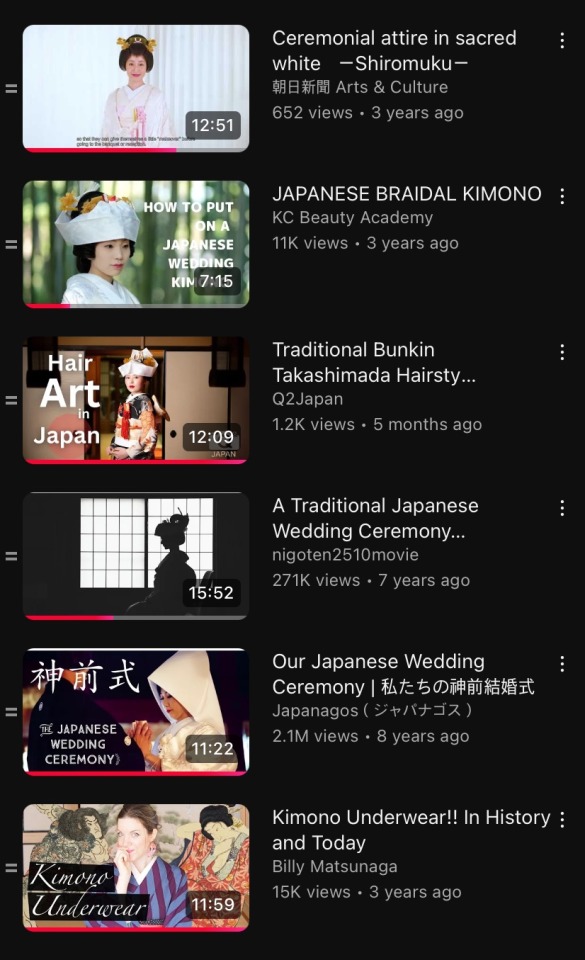
#this post was brought to you by both ffxv and umineko#kind of scattered all over the place but this isn't mean to be educational#wedding wear for writing stuff#there is so much stuff i didn't put into this post it's not funny but my brain is fried#and this has been sitting in my drafts for literal months#I'm pretty sure I'm missing a few sources and I'm so sorry for that
1 note
·
View note
Photo
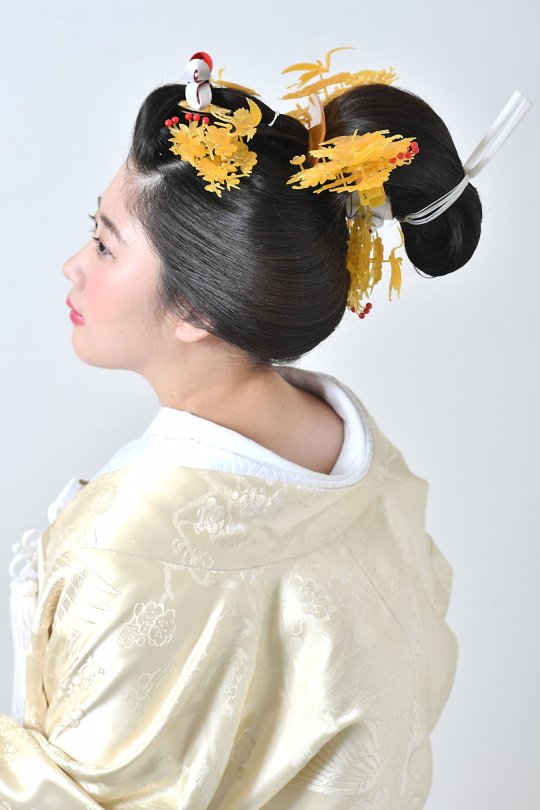
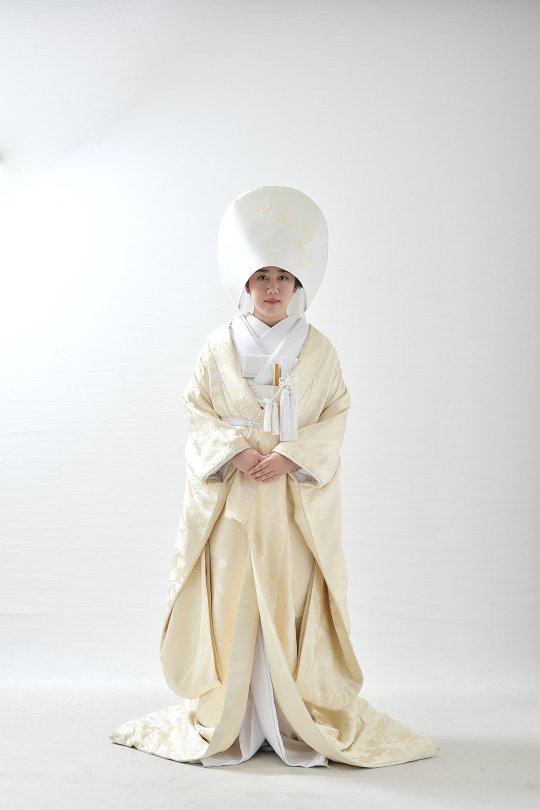
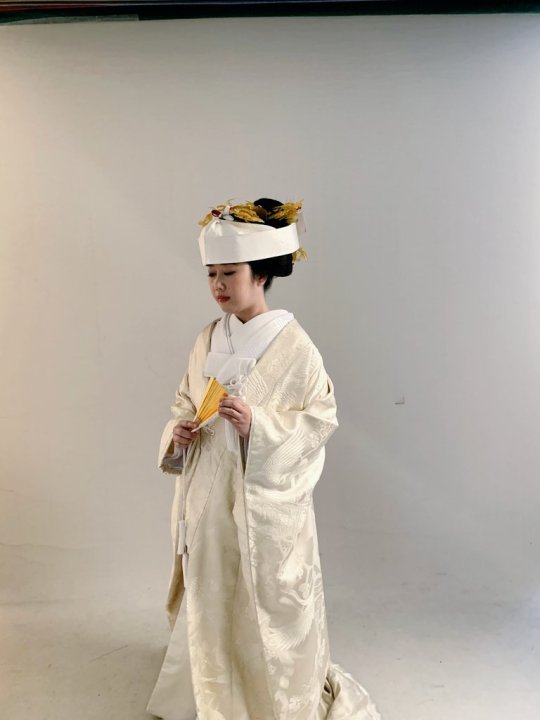
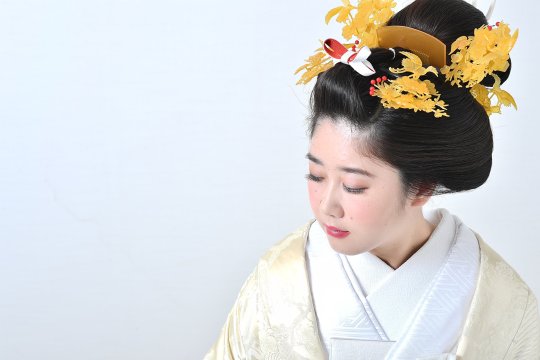
Traditional bride white kimono attire (shiromuku), by Sai kimono.
The model natural hair is styled in formal bunkin takashimada (usually nowadays, most brides chose to wear wigs). You can also see here the two kind of “veils”, the wataboshi (half moon shaped cotton hood) and tsunokakushi (”horn covering” cotton band)
#japan#fashion#kimono#obi#bridal hat#Japanese bridal dress#shiromuku#bride#bunkin takashimada#wataboshi#nihongami#tsunokakushi#着物#帯
154 notes
·
View notes
Photo









Source: http://nihongami.blogspot.com/2018/05/blog-post_23.html
Japanese Hairstyles: Historical Overview Part 02: Women’s Hairstyles of the Edo Period, Part 03
Hairstyle Name: Odori no Kai-you Taka-Shimada (踊りの会用高島田) lit. “Dance Party High Rice Paddy Island”
This is a Shimada topknot with a high base for the knot. The form of this hairstyle is nearly identical in the Bunkin-Taka-Shimada, Hariuchichi, and Yakko-Shimada styles. It seems to have occurred in various forms since the mid-Edo period. Its elegance and dignity of form makes it one of the favorite styles of the upper classes, especially the samurai class, by the late Edo period. This is now widely used by traditional brides during the wedding ceremony.
#kimono#nihongami#edo#edoperiod#edonihongami#takashimada#taka#shimada#shimadamage#bunkintakashimada#bunkin#nihongamitimeline#nihongamitimeline03#nihongamitimeline03e#odori#kai-you#odorinokai-you#odorinokaiyoutakashimada
30 notes
·
View notes
Photo

Today’s Paper Doll Is: A Japanese Bride
“This modern-day Japanese wedding dress is based on a traditional style. The bride wears two kimonos during the wedding--this one is the outer kimono, or uchikake, made of gorgeously brocaded silk. This kimono is first crafted and then painstakingly printed so that its seams will not interfere with the pattern of the print. Bright red is believed to ward off evil spirits. The bride’s traditional hairstyle--bunkin-takashimada-- is adorned with ornaments (kanzashi), combs, and other accessories (her open fan indicates her happiness). Under the uchikake she wears a white kimono called a shiro-maku, which indicates her purity and peaceful nature. A white obi (wide sash) is worn with this kimono. With the shiro-maku she wears a circular hood called a tsuno-kakushi.”
6 notes
·
View notes
Photo








Source: https://nihongami.blogspot.com/
Japanese Hairstyles: Historical Overview Part 02: Women’s Hairstyles of the Edo Period, Part 03
Hairstyle Name: Taka-Shimada (高島田) lit. “High Rice Paddy Island”
This is a Shimada topknot with a high base for the knot. The form of this hairstyle is nearly identical in the Bunkin-Taka-Shimada, Hariuchichi, and Yakko-Shimada styles. It seems to have occurred in various forms since the mid-Edo period. It’s elegance and dignity of form makes it one of the favorite styles of the upper classes, especially the samurai class, by the late Edo period. This is now widely used by traditional brides during the wedding ceremony.
#kimono#nihongami#edo#edoperiod#edonihongami#takashimada#taka#shimada#shimadamage#bunkintakashimada#bunkin#nihongamitimeline#nihongamitimeline03#nihongamitimeline03e
46 notes
·
View notes